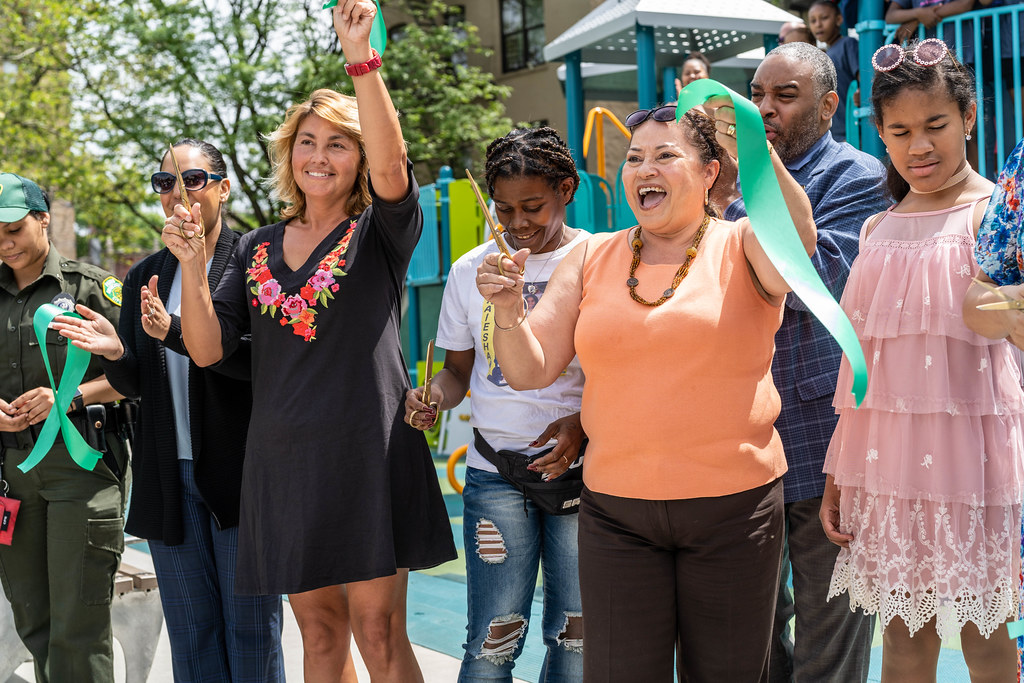Department of Environmental Protection Joins NYC Parks to Cut the Ribbon on the New Saw Mill Playground in South Bronx
June 11, 2019
New Green Infrastructure will Absorb Stormwater, Help Cleanup the Harlem River, and Improve Air Quality
The New York City Department of Environmental Protection (DEP) joined NYC Parks’ Bronx Borough Commissioner Iris Rodriguez-Rosa, City Council Member Diana Ayala, students and administrators from P.S. 369, and local community members to cut the ribbon on a total reconstruction of Saw Mill Playground under the Community Parks Initiative (CPI). The project was funded by $6.6 million from Mayor Bill de Blasio and a $1.4 million allocation from DEP for green infrastructure that will help to improve the health of the Harlem River.
To manage stormwater runoff, green infrastructure, including permeable pavement and rain gardens, has been added throughout Saw Mill Playground, which is able to capture 1.3 million gallons of stormwater every year. DEP has committed approximately $50 million in funding for green infrastructure installations at CPI sites throughout the city, helping to reduce sewer overflows that sometimes occur during heavy rainfall, improve air quality, and lower summertime temperatures.
&ldqo;DEP is proud to be a partner in NYC Parks’ Community Parks Initiative which is transforming neighborhood parks across the city,&rdqou; said DEP Commissioner Vincent Sapienza. “We are always looking to reduce the volume of stormwater that enters our sewer system and we were able to do just that with this project at Saw Mill Playground. The newly installed green infrastructure at the playground will help to reduce stormwater runoff, improve the health of the Harlem River, and beautify the neighborhood.”
&ldqo;We are elated to cut the ribbon on the transformed Saw Mill Playground. With the new amenities and features, we are confident it will be a community hub,&rdqou; said Bronx Commissioner Rodriguez-Rosa. &ldqo;We just want to thank the Mayor and our partners at DEP for this critical investment that improved the park and the quality of life for this community. We look forward to unveiling the brand new comfort station in the fall.&rdqou;
The newly transformed Saw Mill Playground features revamped basketball courts, new play equipment, youth fitness equipment, a synthetic turf field, multi-purpose area, and spray showers. In the fall, a newly constructed comfort station will open, bringing an added convenience to Saw Mill Playground and the Mott Haven community.
Launched by Mayor de Blasio in October 2014, CPI strives to make NYC Parks a more equitable and accessible parks system by investing in smaller parks that are located in New York City’s densely-populated neighborhoods with higher-than-average concentrations of poverty. Through CPI, the City is investing $318 million in capital dollars to make renovations to 67 parks citywide that have not undergone significant improvements in decades.
This playground is named for Saw Mill Creek, also known as the Mill Brook, which once flowed by this parkland. The creek originated in Gates Place in the North Bronx, ran along what is now Brook and Webster Avenues, and emptied into the Bronx Kill. Sawmills flourished along the many tributaries of Bronx waterways for more than two hundred years. The early sawmill, devised in 1352 in Europe, was dependent on water as both a power source and a means of transporting goods. Logs were floated downriver to sawmills, which cut raw lumber into standardized shapes and sizes for building purposes. Another byproduct of the sawing process was wood pulp, from which paper is made. Due to the abundance of lumber and waterpower in the Hudson River Valley, sawmills became a popular and lucrative industry for 17th Century European settlers.
DEP manages New York City’s water supply, providing more than one billion gallons of water each day to more than nine million residents, including eight million in New York City. The water is delivered from a watershed that extends more than 125 miles from the city, comprising 19 reservoirs and three controlled lakes. Approximately 7,000 miles of water mains, tunnels and aqueducts bring water to homes and businesses throughout the five boroughs, and 7,500 miles of sewer lines and 96 pump stations take wastewater to 14 in-city treatment plants. DEP has nearly 6,000 employees, including almost 1,000 in the upstate watershed. In addition, DEP has a robust capital program, with a planned $20.1 billion in investments over the next 10 years that will create up to 3,000 construction-related jobs per year. For more information, visit nyc.gov/dep, like us on Facebook, or follow us on Twitter.





